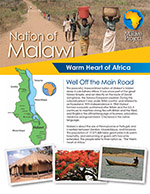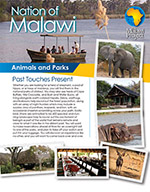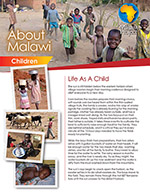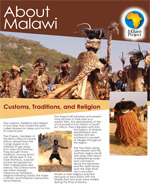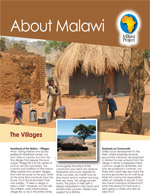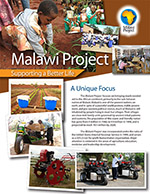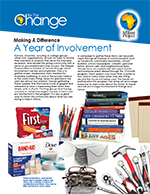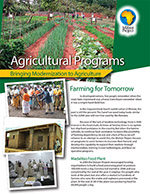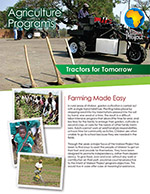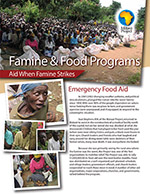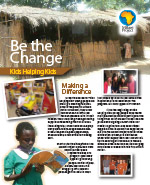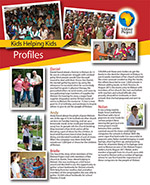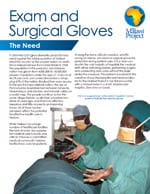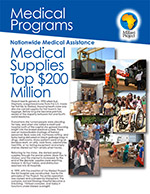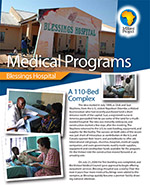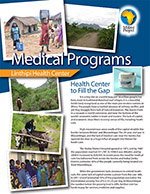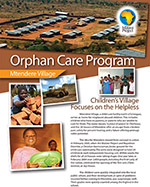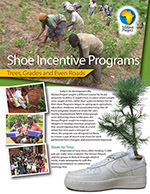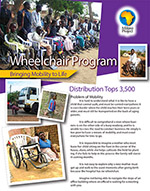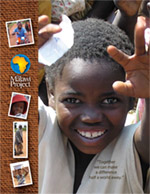Malawi – Nation
This 4-page, full color flyer gives an overview of the nation of Malawi. Whether you are traveling to Lake Malawi, Mount Mulunje, or the Viphya Plateau you will find some interesting, basic information about landscape, travel, government, weather, healthcare, education, religion and the economy in the “Warm Heart of Africa”.
If it is lion, hippo, or crocodile you want to see you will not be disappointed in Malawi. The system of national parks have a sufficient number of wild game, and exotic birds to give your camera a real work out. This flyer gives the names of the major game parks and names of animals you will see in Malawi.
Be careful, you will loose your heart to the warm and friendly children of Malawi. Whether you are challenged with a game of soccer or bargaining the purchase of a galimoto, these young people will make an impact on you that will last a lifetime. Read what childhood is like in one of the poorest nations in the world.
While portions of the nation are moving into a more western world in religion and culture, there is still the link to ancient cultures, religions, and tribal backgrounds. You don’t want to miss the differences in the various tribal and cultural backgrounds that denote each portion of the country in its individual uniqueness to all others.
Unlike many nations where cities or landscape define their character, the village holds the #1 spot when it comes to reflecting the heartbeat of the culture. One can easily see life in the village as it has been for 500 years. Governed by Tribal Authority the village is the link that holds each family close to every other family living nearby.
The Malawi Project
This 4-page flyer offers background about some of the unique ways the Malawi Project approaches its work in the “Warm Heart of Africa”, as well as the way it gives assistance to other nations and organizations. With a small, lean-team the Project has achieved major accomplishments in the fields of agriculture, education, medical, and in long-term programs that develop self-reliance.
This 4-page flyer describes a 12 month program for schools, churches, scouting, or college groups to collect much needed everyday items for donation.
At the grassroots level the Malawi Project has been assisting village farmers in a move from hand-held hoes and simple watering cans to more mechanized programs through the invention of small, custom-made farm tractors, widespread use of drip irrigation systems, and agricultural training programs along with development of facilities to help process and distribute farm commodities.
In the fields of Malawi two new, innovative farm tractors have come into being. The first, referred to as the V-Tractor (V is for Village), is the larger of the two and cultivates larger village tracts in rapid time. The smaller unit, similar to an American walk-behind, roto-tiller, works the soil in a smaller area. The small units is the least expensive to own and operate.
When weather conditions rob the land of its needed nourishment, or too much rain erases a village harvest before its time the Project moves from agricultural development to famine and food relief. This has happened two times the past 22 years and each time the Project changes from long-term production sustainability to more immediate food survival.
Over the years one of the most successful programs is that of young people setting out to help Malawi, Kids Helping Kids. Whether it is school textbooks, band-aids, aspirin, pens, pencils or other school supplies; whether it is eye-glasses, soap or other hygienic needs, groups of young people know no bounds when it comes to helping Malawi.
It is one thing to know massive amounts of aid is going to Malawi to help through the “Kids Helping Kids” program. It is something different to read and see pictures of the inspiring stories of individual young people who have set out to make a difference and are reaching goals few adults could have imagined.
One can hardly imagine being a doctor, nurse, or first responder going into surgery or to an accident scene without any type of rubber glove protection from serious disease implications. However, all over Malawi every day this is a common scene. These brave people know the possible consequences but they also know their patients need them. Isn’t it time we help them protect themselves from harm while they are protecting others?
In the past 21 years well over 200 million dollars in medical aid has been sent to over 700 government hospitals and healthcare facilities. This flyer gives information on the state of healthcare in Malawi and the resources the Malawi Project has made available to the nation.
In 1999 the Malawi Project and a Malawi businessman set out to build a medical facility north of the capital city of Lilongwe. Over the next seven years a state-of-the-art five building, the 110-bed medical complex was completed south of the Lumbadzi Trading Center across from Kamuzu International Airport.
Working with the Dzidalira Community Development Organization the Malawi Project is helping raise funds to construct a new maternity clinic in the mountains north of the Dedza Trading Center. Villages in the area have completed a road to the site and made over 100,000 bricks by hand for the buildings. Dzidalira has completed surveys and all other government requirements opening the way for construction. Funds are needed for the building.
In 2002 the Malawi Project and a Malawi businessman fulfilled a dream and broke ground for the construction of a village for the care of neglected and orphaned children. Funds and support followed and today a 26-building complex houses 160 children near Blessings Hospital just south of the Lumbadzi Trading Center.
In an effort to help the people of Malawi get on their feet with programs that reward creativeness and accomplishment the Program has delivered over 80,000 pairs of shoes to be used in programs where local villagers plant tree seedings and children improve school grades and are given new shoes as a reward for their efforts.
In a program to give mobility to those who are unable to move about freely over 3,500 wheelchairs have been delivered to recipients in all three regions of Malawi. In a number of cases this ability gives the recipient the ability to be self-supporting and independent. For school children it means they can go to school taking a major step toward future independence.
Malawi Project: Annual Report


